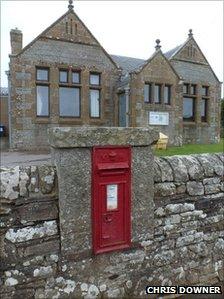Census study shows Caithness's Gaelic past
- Published

Reay was among the places in Caithness where Gaelic was used
New research claims that the Gaelic language was indigenous to many areas of Caithness - surviving into the 20th Century.
Opponents of Highland Council's policy on bi-lingual road signs have often claimed that Caithness heritage is more Norse than Gaelic and that the county was never Gaelic-speaking.
Even where it is conceded that the language was spoken in Caithness, it is often claimed to have been hundreds of years ago.
But a new breakdown of official census figures for the county's parishes suggests otherwise, showing the remnants of an indigenous Gaelic population still speaking the language into the twentieth century.
It was carried out by Hamburg-based researcher Kurt Duwe and published on the Celtic languages research website Linguae-Celticae.
The 1911 census reveals that 1,985 people spoke Gaelic in Caithness - 6.2% of the population.
The language was, however, in a process of decline, which was to see its demise in the county later in the century.
In the 1881 census 3,422, or 8.8%, were Gaelic-speaking, out of a total population of 38,868.
Relatively strong
But a breakdown by Mr Duwe of the census figures for the various parishes of the county is even more revealing.
It shows that Gaelic was spoken by up to a fifth of the population in some civil parishes into the 20th Century.
The language was still relatively strong in the western parishes of Reay, Latheron and Halkirk.
The official census returns show Reay and Latheron parishes were still 18.8% Gaelic-speaking in 1911, just three years before the outbreak of World War I.
In Latheron, 850 people aged three years and over spoke Gaelic, in a total population of 4,520.
Reay showed 173 speakers in a population of 920. Of 2,158 people in Halkirk parish, 177 people spoke Gaelic - 8.2% of the population.
Even in the parish of Thurso, there were 216 speakers (5.4%).
Sutherland clearances
Thirty years previously, the language had been even stronger.
In the first census which measured Gaelic, in 1881, 8.8% of Caithness inhabitants spoke the language.
In Latheron, that amounted to 1,914 people - 28.7% of the population.
There were 477 speakers in Reay (39.8%) and 253 in Halkirk (9.4%).
Even in the more central parish of Watten 167 people (11.9%) spoke Gaelic in 1881, although that had dropped to 4% by 1911.
Mr Duwe's research suggests that the vast majority of these speakers were native-born Caithness Gaels - not refugees from the Sutherland clearances.
Available data from the 1891 census, previously published by Mr Duwe, shows that "speakers enumerated in Caithness were overwhelmingly born and raised in the county".
Of 2,079 speakers in Latheron at that time, 1,813 (87.2%) were native Caithnessians.
The figures seem to support much earlier writings which suggest that in the 18th Century large parts of Caithness - including Wick, Halkirk and Reay - were predominately Gaelic.
In 1707 a presbytery reported to the General Assembly Committee for the Highland Libraries that "there are seven parishes in Caithness, where the Irish (Gaelic) language is used, viz. Thurso, Halkirg, Rhae, Lathrone, Ffar, Week, Duirness.
"But the people of Week (Wick) understand English also."
- Published14 October 2010